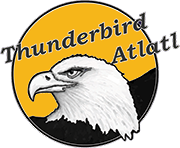
Finished Dart. This dart is made from a 9/16×7′ Thunderbird Atlatl dart shaft, 3 Gateway full length fletches, artificial sinew and Elmers carpenter glue
A properly made dart is the most important part of a spear throwing set. These instructions will take you through the process step by step. Wooden shafts available from Thunderbird are made from straight grained hardwood. However, even the straightest grained wood may need a little straightening. This is accomplished by simply bending the shaft in the opposite direction of the bend. This is most easily accomplished when the dart is relatively new. After several months the shaft will season in and become harder to straighten without heating. If this is the case heat it over a heat source such as a kitchen stove and carefully apply pressure in the opposite direction of the bend (be careful not to burn the wood or your hand). I recommend the use of thick leather gloves for this procedure. Apply light constant pressure, checking often to see if the shaft is straight.
The heat will allow the fibers on the inside of the curve to stretch and the fibers on the opposite side to compress. Cooling will allow the wood to “set†and remain straight. Be patient and work back and forth over the full length of the shaft until all the curves and bends are straightened out. Be careful to not char or burn the wood. The tip of the dart is already tapered for the field points enclosed in your kit. The top of the dart is also finished for using it with your atlatl. Finish the shaft with a waterproof wax or oil. Avoid finish at the tip and where the feathers will be glued or plan to scrape it away before glue is applied.
The best adhesive to apply the field tip with is “amber†hot glue, used in a commonly available hot glue gun. Put the hot glue on the wood, turning the dart shaft to apply it evenly. Heat the field tip at the open end , enough to melt the glue when it is applied to the tapered end of the dart, turning it almost as if you were tightening a screw. The glue will set when it is cool. Wait until the glue is totally cool to the touch before casting it, or you will loose the tip. Do not put the glue into the hollow part of the field tip first as the glue will harden before you can attach it to the wood.
Trim three feathers to the desired length, leaving a ½ ” tab at each end where the vanes are trimmed off. Tie the feathers to the dart with a 4 foot length of artificial sinew or thin thread. The strand of artificial sinew will split into four parts that are perfect for fletching. Be careful to separate it along the natural seams or it will “fuzz upâ€. Start by determining the location of the front end of the fletching. Allow 1 ½’ from the back end of the dart to the back end of the fletching. Use a dab of glue to embed the thread at the front end of the fletching. Roll just enough of the thread onto the dart until it “catches”. Then place the first feather with the front tab centered over the thread. Wrap it twice and add the next feather the same way, then finish with the third. The three feathers should be evenly spaced around the round dart. After covering the tabs with thread, start wrapping the thread through the vane in a helical fashion. The best results are achieved by wrapping at the same angle as the vane leans back from the quill. Finish by covering the back tab with thread. Whip the end with a loop of thread, pull it through and snip off the excess. Smear a daub of glue on the thread at each end. – Bob Berg
Bob Berg With Several Finished Darts. Here is the result of several hours of dart making by Bob Berg. Two of these shafts were painted black.


What kinds of feathers should I or can I use for my Darts ?
We use full length turkey wing feathers.